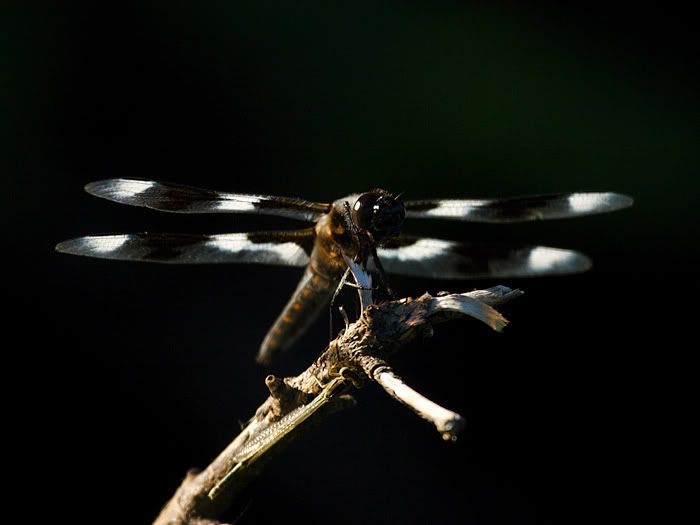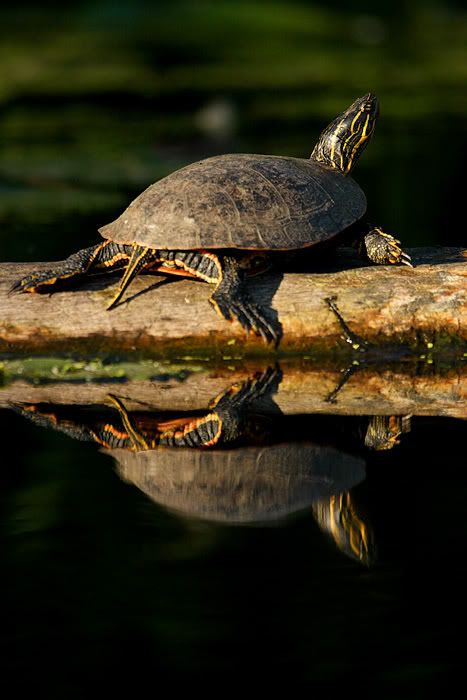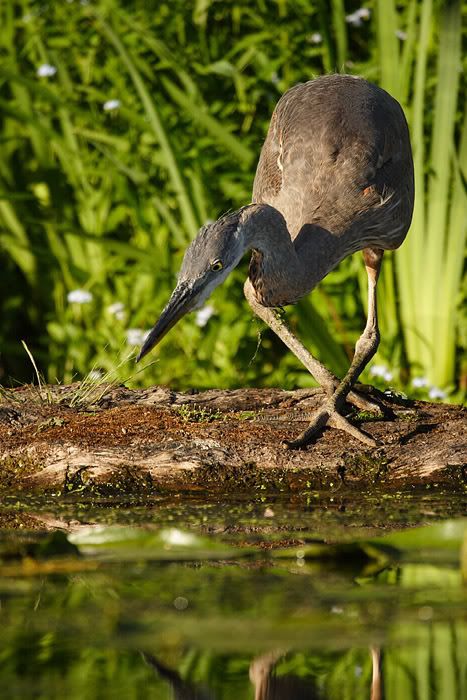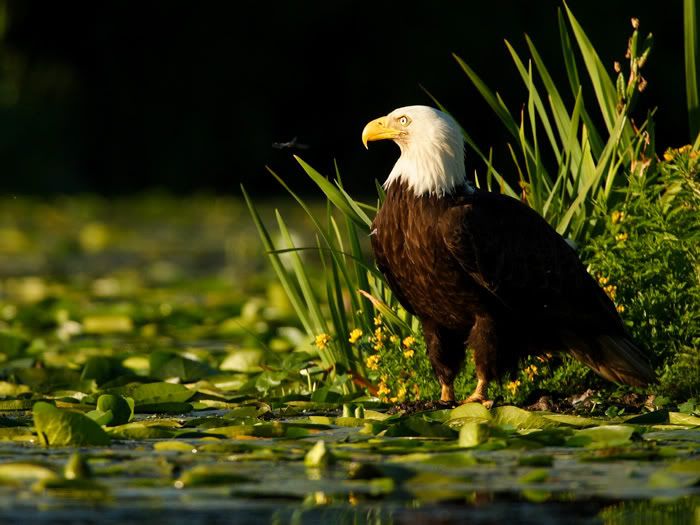The day was warm, and on the water it was the perfect temperature. We both talked about how good it felt to be on the water again. This little wildlife-rich urban haven is one of my favorite sites to visit. On top of that, there is this magic and peace that comes from being on the calm water and floating around slowly amongst the water lilies and cattails.
The first animals we spotted were a pair of dragonflies perching just above the water. They would fly out to hawk insects and then return to their perches. If you look really carefully you might spot another aerial hunter hiding in plain sight right under the dragonfly.
Remember you can view the photos in a larger form if you click on them.

There was only a slight breeze today, and with the afternoon sun at an angle in the sky, there were some absolutely gorgeous reflections on the water. A female mallard posed for a nice photo as we slowly floated by on our raft.

In a quiet corner of the bay within a secluded inlet, we found a large collection of different animals peacefully resting or feeding. Jen and I had become very relaxed and quiet, entering a lightly meditative state that seems to arise naturally from floating calmly on watery environments. When we did speak it was softly, and when we moved it was slowly without any jerky motion.
In this same area of the bay, there were at least 7 female gadwalls swimming around with young ducklings. One of the moms allowed us to come relatively close, but see always kept a wary eye on us. We noticed that none of the mallards had any ducklings in this area, but there was a group of juvenile mallard drakes who were just starting to show green iridescent feathers on their heads.

We noticed how similar gadwall ducklings appeared to our memories of mallard ducklings.
This same area had several logs covered in turtles. As we expected many of the turtles slowly slipped into the water as we came nearer. To our surprise though, there was one particular pair of turtles that allowed us to paddle close and even to hangout next to them for about an hour. Both of the turtles were the same species: painted turtles (Chrysemys picta).

We wondered why these turtles chose to stay while the other turtles close to us slipped away. Perhaps they were mature enough to not be bothered by us, especially since we were for the most part so still and quiet? Or was it something else? Another mystery I hope to some day figure out.
As I mentioned in an earlier post on this blog, painted turtles are one of several species of turtles in Lake Washington. Of all those species, they are certainly the most colorful.
A few meters from the 2 turtles, there was a young immature great blue heron. This particular bird has so much brown in its feathers that we thought it might be less than a year old. From my experience, there are certain things that tend to be consistent with juvenile birds of any species. If you have had the opportunity to observe young birds starting out on their own, you would likely agree that it is usually a humorous event in which the bird is still not sure how it should act. You would not expect a juvenile bird to be a very good hunter.

To our surprise, this heron was a very adept hunter. Its success rate was incredibly high. For every 10 strikes, 7 or 8 of them were successful! It was not striking in a dramatic fashion, but instead making subtle grabs at the surface. Many times it came up with a small fish in its bill, which it quickly tossed back into its throat.
This young heron was very calm and relaxed about our proximity. We were allowed to hang out with it while it hunted, and observe it from about 6 or 7 meters away. It did not show any signs of alarm or nervousness from our closeness.
At one point while watching the heron, we spotted a river other moving quietly in the shadows. It was aware of us and was clearly trying to move about unseen. It paused in its slow swim to stare at us for what seemed like a long moment. Then it disappeared, totally. I did not have a chance to snap any photos of it.
Quite suddenly, the ducks around us started to get nervous and went from sleeping on logs or feeding calmly on the water's surface to starring past us up the channel. Then, nervousness became more intense fear and several ducks actually flew out of the inlet and out into the greater bay. The ducks that were on the logs jumped off into the water and hid. The momma gadwalls and their ducklings swam to a vegetated island and hid among the branches and cattails.
What had scared them was a group of paddlers coming into the channel. The paddlers were in kayaks, which were painted in bright colors and they were using brightly colored paddles as they came near. The sounds of their voices cared into the inlet ahead of them.
How amazing that the animals reacted so much differently to us versus to the group of kayakers?! What was it the animals picked up from them that created so much fear?
One of the turtles near us dove into the water, and even the juvenile great blue heron stood up erect in a nervous posture. The otter was no where to be seen.
We decided to leave the inlet and paddle out into the bay. On the way, we spotted a bald eagle sitting on a weeping willow and looking out towards the distant peak of Mt. Rainer.

As we watch, a group of people in a canoe paddled closer for a photo of the eagle. But, they pushed to close for the bird's comfort and it flew out of the tree. Surprisingly it flew closer to us, and land at the far end of the same small island from which the willow grew. It stood on the edge of the cattails and iris for some time and looked around. We very slowly moved a little closer, but watched carefully for any sign of nervousness from the eagle.
The bird remained where it was, and even started drinking from the lake.

The eagle allowed us to float there and observe it as it took several drinks from the lake. Then, when one of the kayakers we had seen earlier arrived on the seen the eagle appeared more nervous and turned around and walked into the cover of the vegetation you can see behind it in the photo. Next, after a few moments it flew up and away into the inlet and beyond.
We paddled towards the stadium now, and spotted several nutria feeding in the water as they floated. The Union Bay Natural Area has become somewhat famous for these rodents. They are relatively easy to observe from the water if you know where to look.

Notice the position of this nutria's body? The back is arched, the tail is up and the face is well out of the water. This is a typical feeding pose they use while feeding and floating at the same time. I think the tail acts as a kind of counter-balance to help them float more easily. Notice also, the grayish nose, long whiskers and round, rat-like tail of this animal. These are some of the key features you can use to tell them apart from beavers and muskrats, both of which can be observed at the UBNA given you're there at the right time of day.
Overall, it was an amazing afternoon at this wonderful urban wildlife gem. Looking forward to many more outings into the area in the near future. Stay tuned for updates.
5 comments:
Hi Filip,
I enjoyed your story. I'd like to see a picture of your raft, I'm typically out in a white kayak, and now I'm wondering if that can scare wildlife away,
Best,
Julie W.
I think that attitude is the most important thing. Feeling you belong is perhaps the most important. Animals pick up on it.
Nice to have found your blog Filip. Beautiful pictures and all the best to you and Jen. :)
Hey Filip!
Phenomenal photos on the lake, just awesome! I love that heron one. Can I use it for the Tourist Test this year?
Chris
Chris, email me about the Tourist Test. I can't find your email since you don't have a profile.
Post a Comment